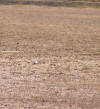(Note from
editor:) Please read the following communication regarding proper
behavior in approaching a nest. We observed that the bird will leave the nest to distract an observer even
if one is walking on the public path about 100' to the south... Here is the remedy ...
Please address questions to:
Steve Henry
Senior Biologist
U.S. Fish and Wildlife Service
2493 Portola Road, Suite B
Ventura, CA 93003
(805) 644-1766 (office)
(805) 644-3958 (fax)
steve_henry@[remove]r1.fws.gov
6-11-03
Steve Henry Steve_Henry@[remove]r1.fws.gov ,
Thanks for your e-mail. I left a
message on you voicemail just now (6-11-03 11 AM). Thank you for your offer
to help address this situation. Local birding expert Freeman Hall was the
closest thing I had to an expert when we went to investigate this activity
in our "back yard." I relied on his good judgment for doing what was
appropriate. I requested our City Parks people to take appropriate action,
but you guys no doubt know best, and can advise the proper remedy. Would you
please recommend the correct action to be taken to those who maintain the
park (Morro Bay City). If nothing is done this poor bird may be taken due to
the heavy recreational foot traffic in the area. I have added your e-mail
message to the other information at the web site
http://morro-bay.com/birding/plover/
with your warning, and added a personal plea to others to please stay far
away. So that others will be aware of the proper protocol, can you please
give me more specific information as to the proper public behavior, and I
will be glad to publish that. Best Regards,
Mike Baird mike@[remove]mikebaird.com
http://mikebaird.com
http://morro-bay.com
Morro Bay, CA phone (805) 704-2064; Volunteer Docent, California State
Parks.
-----Original Message-----
From: Steve_Henry@[remove]r1.fws.gov [mailto:Steve_Henry@[remove]r1.fws.gov]
Sent: Wednesday, June 11, 2003 9:36 AM
To:
mike@[remove]mikebaird.com
Cc:
alueker@[remove]morro-bay.ca.us
Subject: SNPL nest at Cloisters
Mr. Baird,
I was forwarded the email below
regarding the plover nest at the Cloisters. I am concerned that activities shown
in the photos, such as approaching a nest to measure eggs or photograph it
to scale, may have been done by persons not permitted to undertake such
activities. Showing these pictures on a website may lead others to believe
that this is an acceptable activity. Also, erecting an exclosure
around a western snowy plover nest should only be done by permitted persons
trained in erecting exclosures. Conducting these type of activities without
training and being permitted could lead to take of this federally listed
species. I have tried to call you at the number listed below, but have been
unsuccessful. Please contact me if you have any questions.
Steve
P.S. It is not unusual for plovers to
nest in habitat similar to what is shown in the pictures found on the
website listed below. The coastal population of western snowy plovers can
nest a mile or more inland from the ocean on substrate ranging from dirt to
concrete.
Steve Henry
Senior Biologist
U.S. Fish and Wildlife Service
2493 Portola Road, Suite B
Ventura, CA 93003
(805) 644-1766 (office)
(805) 644-3958 (fax)
steve_henry@[remove]r1.fws.gov
----- Forwarded by Steve Henry/VFWO/R1/FWS/DOI
on 06/11/03 09:08 AM -----
<< Andrea Lueker,
alueker@[remove]morro-bay.ca.us (805) 772-6278
6-9-03 Morro Bay
A Western Snowy Plover nest (we saw one
parent with three eggs) was discovered inland in the Morro Bay Cloister's
drainage area today. Since this nest is on City park property, would you
please consider erecting a temporary enclosure like a plastic construction
fence to protect this nest? There is regular foot traffic in the area and
the nest is quite vulnerable. The nest is marked with ten small one-foot
wood sticks in a 12' diameter circle around the nest, but they are not very
visible.
Details of location, photos etc. are
documented at
http://morro-bay.com/birding/plover/
. The nest is known to be at least one week old. The nest identification was
confirmed by local birding expert and State Park docent Freeman Hall (805)
772-3578. This is an interesting observation because popular theory is that
(the "coastal-location species" of) these threatened birds nest only on
beach areas, and not in nearby inland areas.
One argument for the aggressive
protection of the Morro Strand State Beach Snowy Plover nesting habitat is
that these birds can not nest elsewhere nearby. Is this a
counter-example, or does this represent the successful coping of one bird
displaced from a preferable nesting area? Interesting questions I'm sure for
our local birders and fellow naturalists.
Best Regards, Mike Baird
Mike Baird mike@[remove]mikebaird.com
http://mikebaird.com
http://morro-bay.com
Morro Bay, CA phone (805) 704-2064; Volunteer Docent, California State Parks
Note added to
http://groups.yahoo.com/group/slocobirding/message/2373
post:
If you go to observe this nest,
please do so from a respectful distance, as
the parent bird appears to be much more aware of and fearful of intruders
than those found in the sandy beach areas on Morro Strand.
Remedy:
From: Andrea Lueker [mailto:ALueker@[remove]morro-bay.ca.us]
Sent: Wednesday, June 11, 2003 12:05 PM
To: mike@[remove]mikebaird.com
Cc: Bob Hendrix; Rob Schultz
Subject: Birds
Mike,
The City is the group that has
coordinated the efforts to construct the enclosure and also worked with
Steve of Fish and Wildlife.
Andrea Lueker
|







![]() 6-24-03 Hi Mike,
6-24-03 Hi Mike,